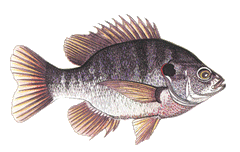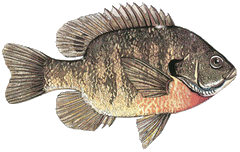“Bluegill vs Hybrid Bluegill?” This is one of the most frequently asked questions when stocking a pond, and usually the second question is “which is better?” The answer to both questions is “it depends on the circumstances and preferences.”
Hybrid Bluegill
The Hybrid Bluegill is a cross between a Male Bluegill and a Female Green Sunfish, and is sometimes referred to as a Hybrid Sunfish. As a result of the cross the Hybrid Bluegill is ~80-90% male, giving it a reduced reproductive potential and making it an ideal choice for those ponds prone to Bluegill stunting. Also, when Hybrid Bluegill reproduce in a pond, their offspring is generally not very successful or desirable, which makes it necessary to restock occasionally. When you stock Hybrid Bluegill, you also have to stock a supplemental forage species for the Largemouth Bass, like the Fathead Minnow or Golden Shiner. In a perfect situation, the minnows or shiners will reproduce and provide feed for the bass. However, the establishment of a forage species can be difficult because Hybrid Bluegill readily consume minnow & shiner fry as they hatch and Largemouth Bass readily consume the adults.
Because of the above limitations, we only recommend stocking Hybrid Bluegill in certain situations. Primarily, the pond owner must be willing to restock Hybrid Bluegill, minnows and/or shiners on a regular basis. The amount of fish to restock and the frequency varies with the initial fish population, fishing pressure and amount of cover. Generally, we recommend restocking 30-50% of the Hybrid Bluegill every 3 years, plus replace the amount harvested annually. For the minnows and shiners, 25-50 pounds per acre on an annual or biannual basis is usually adequate. You can tell if minnows need to be restocked by walking the banks on a warm day. If you see minnows but few, if any bass, then you are ok. However, if you see packs of Bass swimming the shoreline and no minnows, then it’s time to restock.
Bluegill
As most people know, because of their strong reproductive potential, the Bluegill has a tendency to overpopulate in ponds. Most ponds have a limited amount of food available for Bluegill, and as a result, the more fish you have, the less that they will grow. In other words, if you have 1,000 Bluegill in a 1-acre pond they will grow at a certain rate. But if you have 10,000 Bluegill in that same pond they will grow 10 times slower, which is the cause of stunting.
In an unmanaged small pond, Bluegill do have a tendency to stunt. They get to a size that is too large for the Bass to eat and too small for the fisherman to keep, and then you have a problem. In order to prevent this from happening, there are 4 things you must do:
1. Maintain a strong population of predators to keep the Bluegill in check. Many people believe that introducing a couple Northern Pike is the solution to this problem, but they can actually make things worse. Large predators, like the Northern Pike or Muskellunge, eat the size of fish that you want to catch – not the size that you want to eliminate. Also, they prefer to feed on long tubular shaped fish like the Largemouth Bass instead of difficult-to-swallow Pan Fish, like the Bluegill. This can actually make the Bluegill stunting problem worse because Largemouth Bass are the main predator of small Bluegills. We usually recommend maintaining about 100 Largemouth Bass per surface acre to help control Bluegill.
2. Manage the fish population by harvesting the most abundant size class of the most abundant fish. If the pond has many 3-5” Bluegill and few Bass, then spend some time removing the 3-5” Bluegill. However, if the pond is loaded with Bass under a pound, and Bluegill are sparse, then harvest some Bass. This may sound like common sense advice, but many people are under the impression that catch & release fishing is always best. If done properly, catch & keep fishing can be a powerful management tool. See Largemouth Bass Stunting for more information on this
3. Do not let aquatic weeds or algae get too thick. Most weeds are actually quite beneficial for ponds because they filter the water, stabilize bottom sediment, and provide tremendous fish habitat. However, certain types of weeds can grow to be exceptionally thick in the summer, giving small Bluegill too many hiding places from the Largemouth Bass. In the case of exotic nuisance weeds like Curly-leaf Pondweed or Eurasian Watermilfoil, we recommend complete elimination followed by replanting with native species. However, with native Pondweed species, Coontail, Elodea and many others, spot treatment with proper chemicals or partial harvesting with weed rakes can be very beneficial.
4. Do not harvest the largest Bluegill in the pond. Having large male Bluegill present inhibits the sexual maturation of other Bluegills. Immature Bluegills grow much faster than mature Bluegills because all their energy is going towards growth, and not to the production of reproductive organs. So, if the Bluegill in the pond are kept from becoming sexually mature, they will grow faster. Plus, there will be less reproduction, which will reduce the overall number of Bluegill and thereby increase growth rates because more food is available per fish. See this example of Walnut Lake by the IL DNR for more information on this topic.
When the above steps are taken, Bluegill can have tremendous growth rates, and provide many meals for the fisherman.


